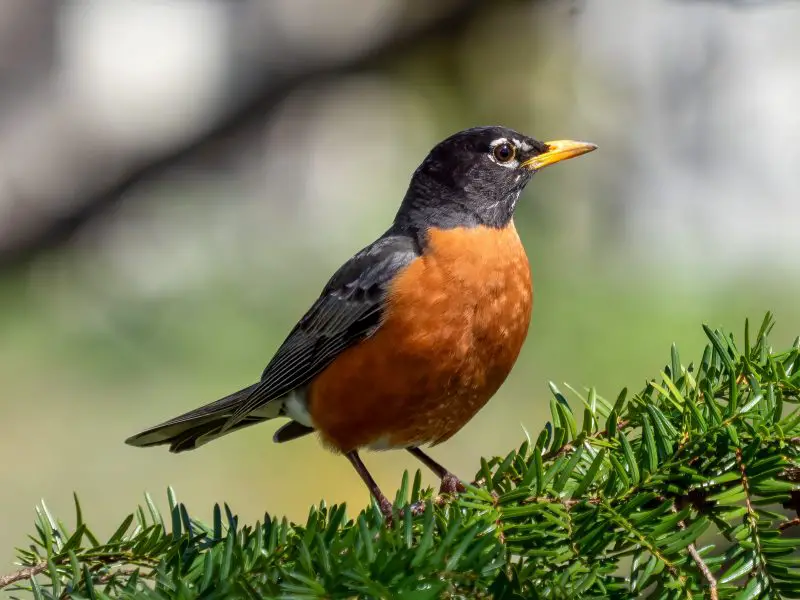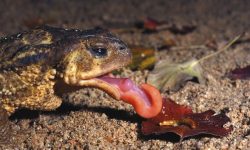The American Robin (Turdus migratorius) is a cherished and familiar presence in gardens, parks, and forests across North America. Known for its bright red-orange breast, cheerful song, and early arrival in spring, this member of the thrush family is one of the continent’s most iconic songbirds. While American Robins are wild birds and generally do not require direct care, bird lovers can support them through habitat enrichment, safe feeding, and ethical interventions when injury or distress occurs.

This guide explores everything North American bird enthusiasts need to know about helping robins thrive in both urban and natural settings.
Understanding the American Robin
Physical Characteristics
The American Robin (Turdus migratorius) is a medium-sized songbird, about 9–11 inches (23–28 cm) long. It has gray-brown upperparts, a bright reddish-orange breast, and a white lower belly. A white eye-ring adds contrast to the face. Males are more vividly colored than females, especially in breeding season. Juveniles have spotted breasts. Their straight yellow beak and strong legs suit their ground-foraging habits.
Behavior and Habits
Robins are active during the day and roost in trees at night. They commonly forage on lawns, using sight and sound to locate earthworms. Their diet also includes insects and berries. They often hop across grassy areas with quick, alert movements. The robin’s song—a clear, cheerful whistle—is used to mark territory and signal seasonal changes. While some remain year-round in milder areas, many migrate south in winter and return in early spring.
Creating a Robin-Friendly Habitat
Yard Design and Landscaping
To attract American Robins, maintain open lawn areas or patches of soft, moist soil where they can easily forage for worms and insects. Avoid using artificial turf or heavily compacted ground, as it limits access to invertebrates.
Plant native shrubs that produce berries, such as serviceberry, dogwood, and juniper. These provide food, shelter, and nesting cover year-round.
Place a shallow birdbath with clean water in a quiet spot. Robins use these for both drinking and bathing, especially in warmer months.
Nest-Friendly Structures
Robins prefer to nest on flat, sheltered surfaces—like eaves, porch lights, and horizontal tree branches. You can support nesting by installing simple wooden robin platforms beneath overhangs or quiet ledges.
Avoid heavy pruning or trimming of trees and shrubs between April and July, which is peak nesting season. Limit disturbances near active nests to prevent stress or nest abandonment.
Feeding American Robins
Natural Diet
Robins are true seasonal diners. In spring and summer, they hunt juicy earthworms, beetles, and caterpillars, probing the soil with sharp eyes and quick beaks. When insects grow scarce in fall and winter, they switch to nature’s pantry—berries, fruits, and the occasional seed.
They’re ground foragers, not feeder birds. To help them out:
-
Set out mealworms in shallow dishes.
-
Offer chopped grapes, raisins, or apple slices.
-
Scatter food directly on the ground or use low platforms where they feel at home.
Avoiding Harmful Foods
While it’s natural to want to feed the birds that visit your yard, not all foods are safe—especially for robins. These birds have specific dietary needs, and even small amounts of the wrong food can do real harm.
Bread and other processed grains, for example, may fill a robin’s stomach but provide almost no nutritional value. Over time, this can lead to energy deficiencies, poor feather quality, and developmental problems in young birds. Dairy products, like milk or cheese, are equally problematic—robins can’t digest lactose, and consuming it may cause digestive distress.
Salted or flavored nuts and seeds pose another serious risk. Unlike some other bird species, robins are not built to handle high sodium levels. Salted snacks can lead to kidney strain, dehydration, and even death.
Perhaps most dangerous of all are pesticide-contaminated foods. Earthworms, insects, and fruit from treated lawns or gardens may carry chemical residues. These toxins build up silently and can cause long-term harm to robins’ nervous and reproductive systems.
The safest approach is to offer only natural, untreated foods—like chopped organic fruits or live mealworms from reputable sources. Clean water is just as important and should always be available.
Recommended and Harmful Foods for Robins
✅ Safe to Offer |
❌ Avoid Completely |
|---|---|
Unsweetened raisins, chopped grapes, apple slices |
Bread, crackers, chips |
Organic blueberries, blackberries, cranberries |
Milk, cheese, yogurt |
Live or dried mealworms (no additives) |
Salted peanuts, sunflower seeds with salt |
Soft bananas or ripe pears (pesticide-free) |
Fruit sprayed with pesticides or herbicides |
Water in a clean, shallow dish |
Sugary fruits or canned fruit in syrup |
Providing robins with safe, nourishing food helps ensure they stay healthy, active, and present in your garden—year after year.
Seasonal Support and Considerations
Spring and Breeding Season
As robins return and begin nesting, they need safe, resource-rich spaces.
Provide moist soil or shallow mud patches—they use mud to build sturdy nests.
Keep cats indoors and deter predators to protect vulnerable eggs and chicks.
Avoid pesticides to keep insect prey abundant and safe.
Summer Heat
Hot days call for cool relief.
Keep birdbaths full, clean, and shaded.
Plant dense shrubs or let some foliage grow thick—robins need shelter to rest and escape the sun.
Fall Migration
Robins gather in loose flocks as they prepare to head south.
Support their journey with fruit-bearing plants like viburnum and crabapple, which offer energy-packed snacks right from your garden.
Wintering Robins
Many robins stay in the southern U.S., but some brave the northern chill if food and water are available.
Help them through by planting winter-fruiting trees and keeping birdbaths ice-free with a heater or fresh water each day.
Helping Injured or Orphaned Robins
When to Intervene
Not every robin you find on the ground needs saving—sometimes, stepping back is the best thing you can do. But in certain cases, your help is truly needed.
Step in if the bird is:
-
Bleeding, visibly injured, or unable to stand or fly
-
Lethargic, shivering, or unresponsive to nearby movement
-
A nestling (featherless or with closed eyes) on the ground, with no nest or parents in sight
These birds are too young or too weak to survive alone and need immediate assistance.
Important: If the bird is a fledgling—fully feathered but with a short tail and unsteady flight—don’t rush in. These young robins are learning to survive and are often still under the watchful care of nearby parents. Watch quietly from a distance. If the bird is active and the parents return within 30–60 minutes, it’s best to let nature take its course.
Intervening at the wrong time, even with good intentions, can do more harm than good. When in doubt, observe first—then act only if you’re sure the bird is in danger.
What to Do
If the bird truly needs help:
-
Call a licensed wildlife rehabilitator as your first step.
-
Place the bird gently in a ventilated box lined with a soft towel or tissue.
-
Keep it warm, quiet, and in the dark—stress can be fatal.
-
Do not feed or give water unless advised by a professional.
Your calm, careful actions can make the difference between life and death—always prioritize expert guidance.
Conservation and Coexistence
Ecological Importance
American Robins are more than just a cheerful sign of spring—they’re vital players in the ecosystems they inhabit. As active insectivores, they help regulate populations of beetles, caterpillars, snails, and especially earthworms, keeping soil ecosystems balanced and reducing pest pressure in gardens and wild areas.
Their love for berries also makes them important seed dispersers. As they forage on fruits from native shrubs and trees, they carry seeds to new locations, contributing to forest regeneration and plant diversity.
Beyond their role as predators and dispersers, robins are also a key food source for others. They are preyed upon by hawks, foxes, snakes, and even larger birds like crows. This positions them as a crucial middle link in the food web—supporting both the species they eat and those that feed on them.
In short, robins are quiet stewards of ecological health—working every day to maintain the natural balance that benefits us all.
Threats
Though American Robins are common and widespread, their survival is not guaranteed. Modern environments present a number of hidden dangers.
Window collisions are one of the deadliest threats. Robins often mistake reflections of trees and sky for open space, leading to fatal impacts with glass.
Lawn pesticides, while aimed at insects and weeds, pose a silent hazard. These chemicals contaminate the worms and bugs robins eat, harming their health and reducing their food supply.
Habitat loss is another major challenge. As urban development expands, natural nesting areas and food-rich green spaces disappear, leaving robins with fewer places to raise young and find shelter.
Finally, predation by outdoor cats and nest-raiding birds like crows and jays puts eggs and fledglings at constant risk. Even in seemingly peaceful backyards, these dangers can be fatal for young robins.
Awareness of these threats is the first step toward creating safer spaces for robins to live and thrive.
How to Help
You don’t need to live in a forest to make a real difference—your own backyard can become a haven for American Robins.
Start by applying window decals or screens to prevent window collisions, one of the leading causes of death for songbirds. Even a few well-placed stickers can save lives.
Next, ditch chemical pesticides and herbicides in your garden. These toxins don’t just kill pests—they wipe out the insects robins rely on and can poison the birds themselves.
Plant native shrubs and trees, like serviceberry, dogwood, or juniper. These plants offer food, shelter, and nesting space, creating a natural, robin-friendly ecosystem right at home.
And finally, talk about it. Share what you know with friends, neighbors, and family. A quick conversation or social post can inspire others to protect the birds we often take for granted. Small acts, multiplied across communities, can change the world—for robins and beyond.
Legal Protections
In both the U.S. and Canada, American Robins are safeguarded by the Migratory Bird Treaty Act. It’s illegal to capture, keep, harm, or destroy active nests without proper authorization. Respecting these laws helps ensure robins remain part of our skies for generations to come.
Conclusion
The American Robin is more than just a common backyard bird. It’s a resilient, adaptive species that brings color and song to North America’s cities and wild spaces alike. By understanding its habits, supporting its habitat, and acting responsibly when care is needed, bird lovers can ensure robins continue to thrive for generations to come.
Whether you’re a seasoned birder or a curious homeowner, there’s always something rewarding about caring for these melodic messengers of spring.






